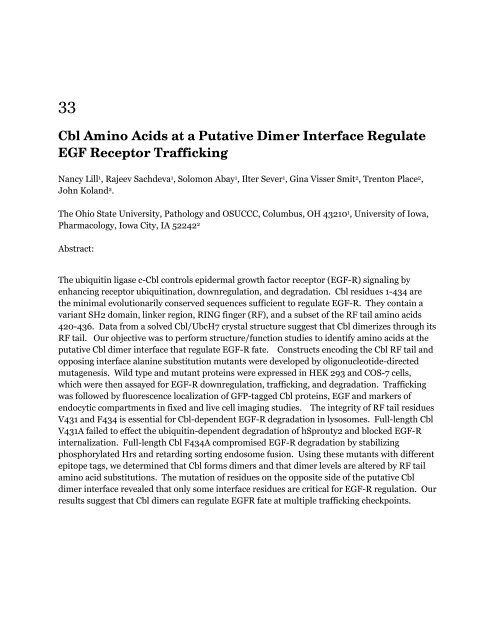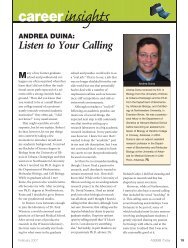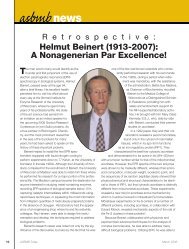View Program - asbmb
View Program - asbmb
View Program - asbmb
- TAGS
- program
- asbmb
- www.asbmb.org
You also want an ePaper? Increase the reach of your titles
YUMPU automatically turns print PDFs into web optimized ePapers that Google loves.
33<br />
Cbl Amino Acids at a Putative Dimer Interface Regulate<br />
EGF Receptor Trafficking<br />
Nancy Lill 1 , Rajeev Sachdeva 1 , Solomon Abay 1 , Ilter Sever 1 , Gina Visser Smit 2 , Trenton Place 2 ,<br />
John Koland 2 .<br />
The Ohio State University, Pathology and OSUCCC, Columbus, OH 43210 1 , University of Iowa,<br />
Pharmacology, Iowa City, IA 52242 2<br />
Abstract:<br />
The ubiquitin ligase c-Cbl controls epidermal growth factor receptor (EGF-R) signaling by<br />
enhancing receptor ubiquitination, downregulation, and degradation. Cbl residues 1-434 are<br />
the minimal evolutionarily conserved sequences sufficient to regulate EGF-R. They contain a<br />
variant SH2 domain, linker region, RING finger (RF), and a subset of the RF tail amino acids<br />
420-436. Data from a solved Cbl/UbcH7 crystal structure suggest that Cbl dimerizes through its<br />
RF tail. Our objective was to perform structure/function studies to identify amino acids at the<br />
putative Cbl dimer interface that regulate EGF-R fate. Constructs encoding the Cbl RF tail and<br />
opposing interface alanine substitution mutants were developed by oligonucleotide-directed<br />
mutagenesis. Wild type and mutant proteins were expressed in HEK 293 and COS-7 cells,<br />
which were then assayed for EGF-R downregulation, trafficking, and degradation. Trafficking<br />
was followed by fluorescence localization of GFP-tagged Cbl proteins, EGF and markers of<br />
endocytic compartments in fixed and live cell imaging studies. The integrity of RF tail residues<br />
V431 and F434 is essential for Cbl-dependent EGF-R degradation in lysosomes. Full-length Cbl<br />
V431A failed to effect the ubiquitin-dependent degradation of hSprouty2 and blocked EGF-R<br />
internalization. Full-length Cbl F434A compromised EGF-R degradation by stabilizing<br />
phosphorylated Hrs and retarding sorting endosome fusion. Using these mutants with different<br />
epitope tags, we determined that Cbl forms dimers and that dimer levels are altered by RF tail<br />
amino acid substitutions. The mutation of residues on the opposite side of the putative Cbl<br />
dimer interface revealed that only some interface residues are critical for EGF-R regulation. Our<br />
results suggest that Cbl dimers can regulate EGFR fate at multiple trafficking checkpoints.






